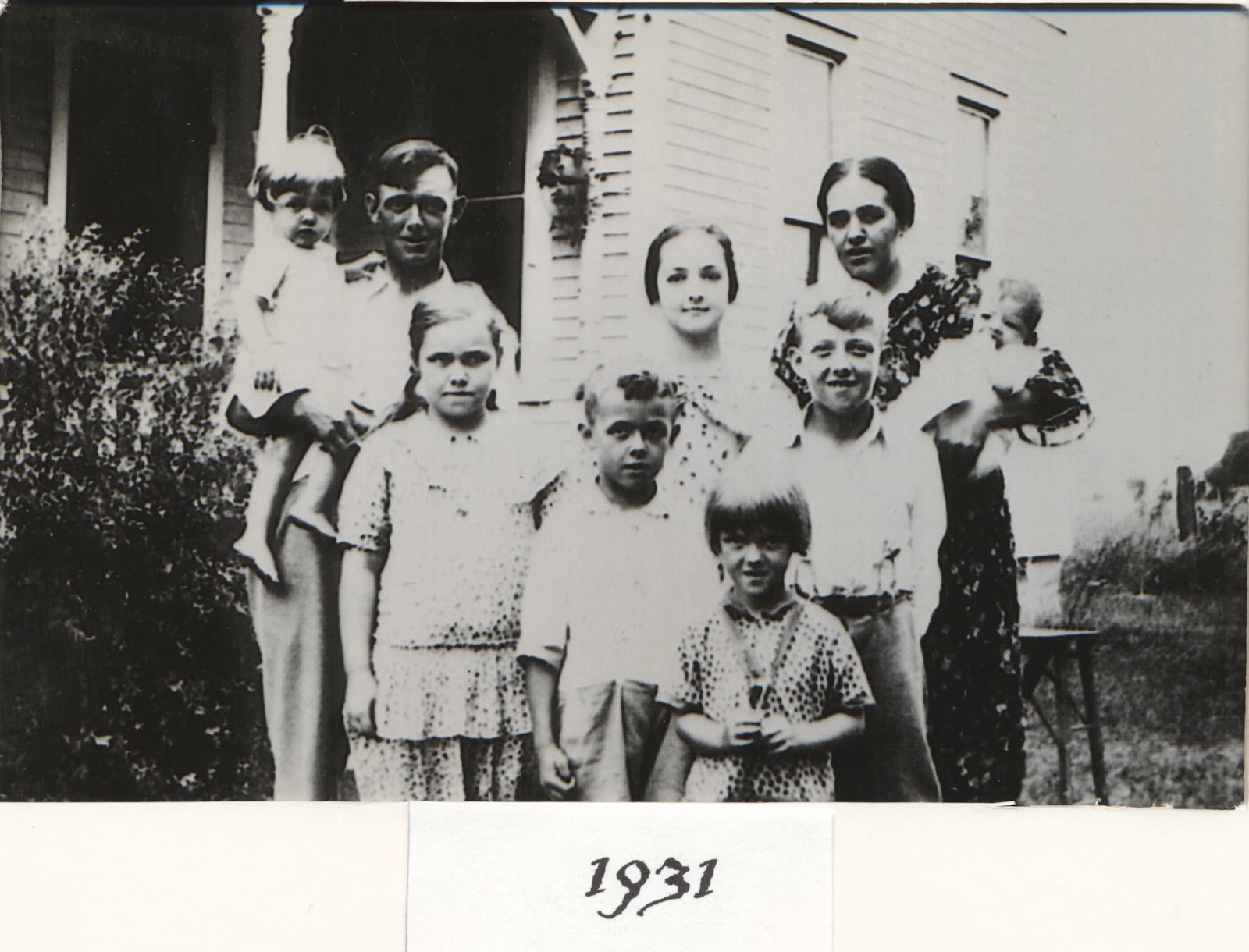|
Rheinheimergenealogypages
including Reinhard, Rheinheimer, Shively, and Stout |
Jacob Rheinheimer (John's son, our great-grandfather)
Uriah Edward Rheinheimer (Jake's son, our grandfather)
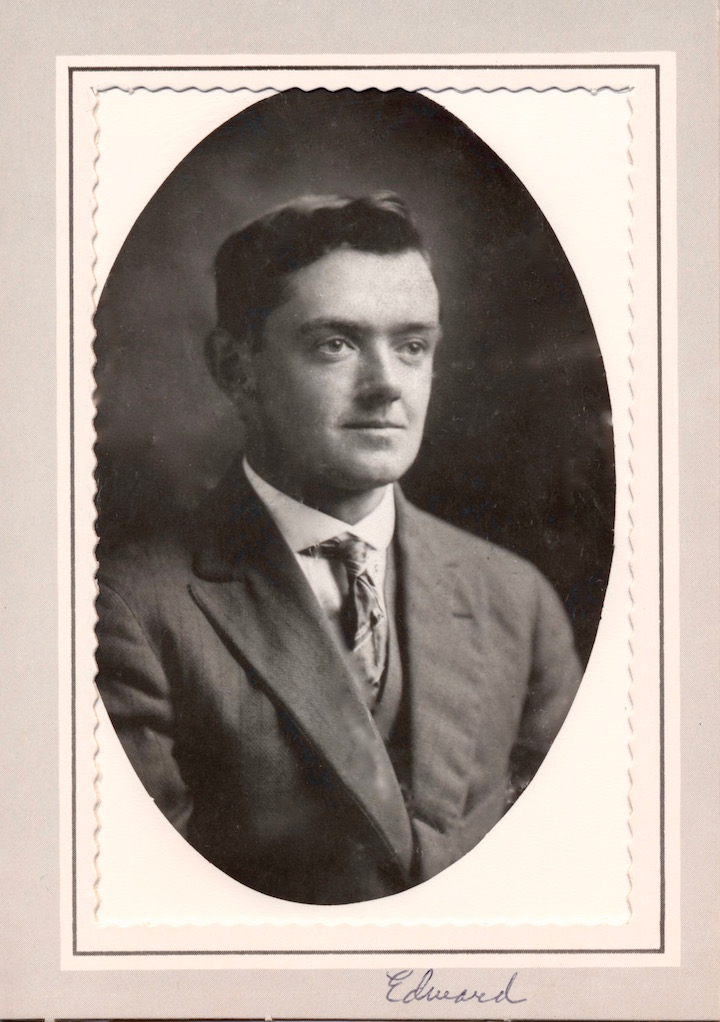 |
| Ed Rheinheimer |
Brief bio:
1891: Born in Pashan, IN near Shipshewana, oldest of three sons born to Jacob and Rachel Sunthimer Rheinheimer.
1894: Age three, his mother died of typhoid fever. Lived with maternal grandfather.
1898: Age 6 1/2, his father married his widowed aunt, Mary Sunthimer Johns.
Completed eight grades of education
1917: Age 26 married 18-year-old Laura Reinhardt, who died in 1994 at age 95. Had eight children. He was a farmer, horse breeder, plumber, carpenter, blacksmith and fisherman.
1972: At age 81, died in Ft. Wayne, IN hospital from truck accident injuries earlier in the day.
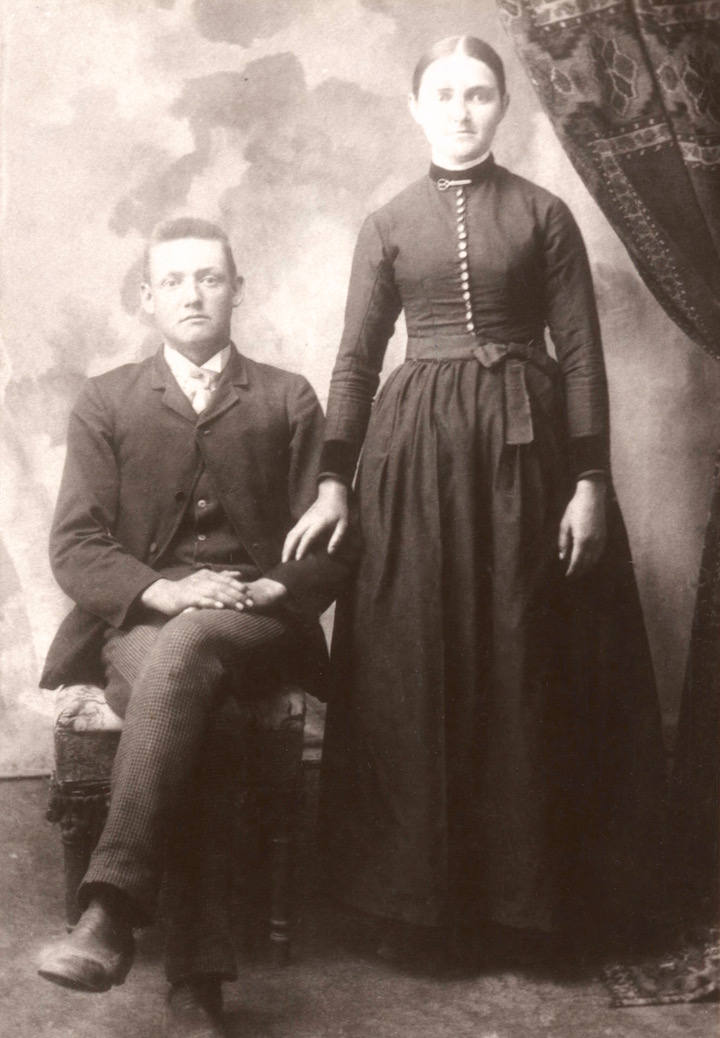 |
| Jacob & Rachel Rheinheimer ~1891 |
1891
After Ed's parents (Jacob and Rachel) married in January 1891, they had three sons in quick succession:
Uriah Edward, b 20 Aug 1891
John Frederick, b 14 Dec 1892
Ira J, b 11 Nov 1894.
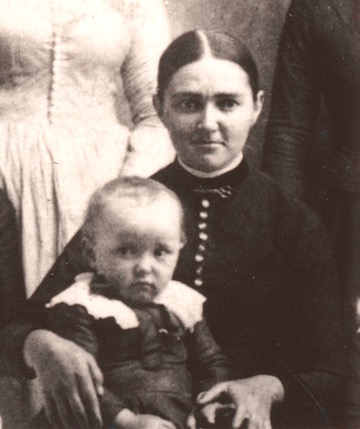 |
| Ed Rheinheimer with mother Rachel, ~1892 |
In the fall of 1894 when Ed was just three years old, typhoid fever swept through the tiny village of Pashan, IN, where he lived with his parents and younger brother on a farm. Many people became ill or died.
His father, Jake, fell unconscious after contracting typhoid. His mother, Rachel, was heavily pregnant with her third son, Ira, and gave birth to him on November 11 while his father was still unconscious. Shortly after Ira's birth, Rachel also became sick with typhoid. Ed's grandmother also died from the fever during this time and at some point, Ed himself also became ill. His uncle Andrew Sunthimer had died the previous month.
His mother succumbed to the disease on December 4th at just 27 years of age when Ed was only three. His father, Jake, eventually regained consciousness only to discover that his wife had died and was already buried, his youngest son had been born and given to friends while he was unconscious, and Ed, his oldest son, was also sick with typhoid fever.
Because the three young brothers were now motherless, they were separated and sent to live with various friends and relatives, a common practice during that time. Edward went to live with his recently widowed maternal grandfather, 57-year-old Frederick (Fritz) Sunthimer, also in Pashan. His two-year-old brother, Fred, lived with Sally Yoder. Childless friends Aaron & Amanda Yoder took baby Ira and reared him to adulthood.
Death also claimed other community members and relatives. Four weeks after his mother died, a second uncle, Jacob Johns, also died from typhoid fever, widowing his aunt Mary (his mother's older sister). Mary now had four small children, which included one of her own (Hettie) and three step-children from Jacob Johns' first wife, Melinda Mehl.
After all these deaths, Ed's father, Jake, began several years of nomadic life. He sold all his possessions and went to Hopedale, Illinois for the summer of 1896 and worked as a hired hand for a farmer because he heard that wages were higher there and he needed more money. But by 1897 his father was again living in Pashan, now with Ed's grandfather, Fritz Sunthimer; his aunt Mary, who had been caring for him, and his cousin, Hettie, Aunt Mary's child with Jacob Johns, her first husband.
Death also claimed other community members and relatives. Four weeks after his mother died, a second uncle, Jacob Johns, also died from typhoid fever, widowing his aunt Mary (his mother's older sister). Mary now had four small children, which included one of her own (Hettie) and three step-children from Jacob Johns' first wife, Melinda Mehl.
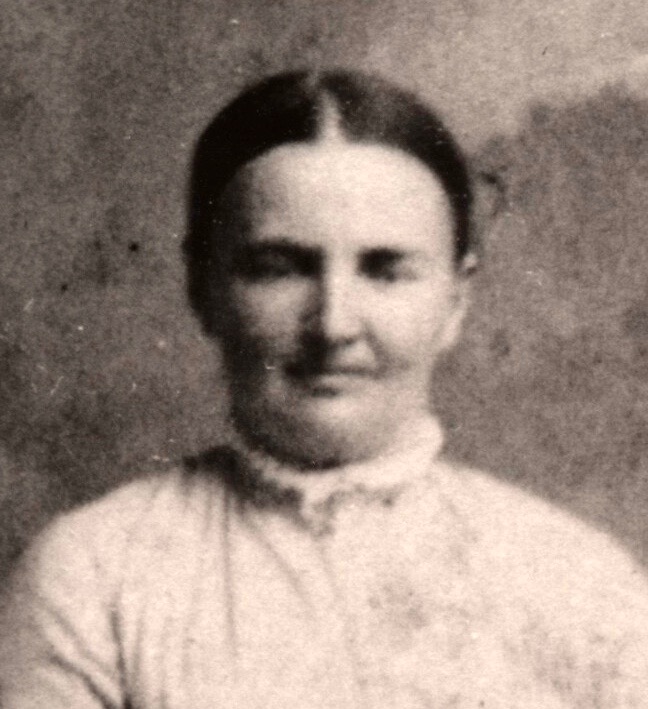 |
| Mary Sunthimer Johns Ed's aunt & eventual stepmother |
1898
Ed's father, Jake, now age 28, married his aunt Mary on 13 March 1898 when she was 36. In their household west of Shipshewana Lake they were now rearing Jake’s sons, six-year-old Edward and five-year-old Frederick, and Mary Ann’s daughter, Hettie, almost four years old. Three-year-old brother, Ira, stayed with his foster parents instead of coming to live with his biological father and aunt since he had been 'given away' at three weeks. Although the remaining three children were first cousins, they were treated as siblings.
Ed continued to live with his father and stepmother through adulthood. Around age 25, when he was working in Kouts, IN, he met his future wife, Laura Reinhardt, by a chance acquaintance through her cousin, Elsie Miller. Laura was the daughter of John Jr and Lizzie Ann Miller Reinhardt. She had five sisters and two brothers: Iva, Laura, Mable, Delcie, Mary, Stella, Florence, Olen, Orrie, and Orvan (1 baby died without being named).
1917
With World War I raging in Europe, Ed and Laura married on Sunday, 11 Nov 1917, in Kouts, IN, when the circuit preacher came through. Unbeknownst to them, their wedding date was a year to the day before World War I would end.
Although the war had begun in 1914, the U.S. had remained neutral, even when Germany sank the British liner Lusitania on 7 May 1915 with 128 U.S. citizens onboard. President Woodrow Wilson declared that "America is too proud to fight" and demanded an end to attacks on passenger ships.
However, despite considerable public opposition, the president declared war on Germany on April 6, 1917. Six weeks later, Congress passed the Selective Service Act on May 18, requiring all men between the ages of 21 and 30 to register for military service.
On Wednesday, June 6, Ed and his brothers, Fred and Ira, each registered. Ed listed his occupation as a farm laborer, employed by his father, Jacob Rheinheimer, in Shipshewana, IN. The last question, #12, asked, "Do you claim exemption from draft (specify grounds)? Ed responded, "yes, Mennonite," as did his brother Ira. Fred left his space blank. Only Ira was drafted into the war.
Despite the provision for conscientious objectors during registration, the Selective Service Act only provided objector status for those who were members of "any well-recognized religious sect." According to Mennonite Central Committee, that phrase proved to be ambiguous for draft boards who were arbitrary in classifying conscientious objectors.
Further, men who objected were not exempt from military service, they still had to serve in the armed forces as a noncombatant. So the military held direct authority over COs (conscientious objectors) and that created problems for many pacifists in the Mennonite church. The confusion and hostility that surrounded the absence of a specific definition of noncombatancy during the first world war led both the government and the objectors to rectify those problems a couple decades later when the second world war loomed for the U.S.
Although Ed would have been drafted in the next round of men, he narrowly escaped that fate with the war's end in November 1918. By then 24 million men had registered for the draft. Of the almost 4.8 million Americans who enlisted, 2.8 million had been drafted.
Is this what happened to Ed's youngest brother Ira? Despite answering Mennonite to the question of exemption on the draft registration form, Ira went into the army on 29 March 1918 and was exposed to poisonous mustard gas in France on 19 Oct 1918, less than a month before the war ended. It was the first time chemical weapons had been used in warfare.
Ira was given an honorable discharge on 9 May 1919. After he came home, he courted and married Anna Hostetler, and had three children, Don, John, and Shirley. Their daughter was born while living in Los Angeles, where they had moved to improve Ira's health. He spent time in the LA Veterans Hospital, making leather purses while there. The family moved back to northern Indiana before he died in 1933 at age 39, able only to speak in a whisper due to the mustard gas damage. His three children were aged 11, 9 and 5. His brother, Ed, was 42.
Laura wrote that Ed had a mouthful of canker sores when they married in 1917 and was being treated for them. They also discovered that he had stomach ulcers. During June of 1921, four months before Floyd was due, Ed was frequently coughing up blood. One time when Ed had four or five bloody coughing spells outside before they finally stopped, Laura said that "it looked like we butchered hogs." Although she called the town doctor, he did not come out for a house call in his horse and buggy, but told her to fix Ed some gelatin tea, which she fortunately had on hand.
Ed did not take the illness seriously and "just laughed and joked about it but I knew there was something serious wrong with him." She answered an ad in a paper from a Dr. Young and he suggested a diet for him that helped considerably. "From then on we had bread and milk for supper every evening. The doctor also said he should always eat cottage cheese with any kind of fruit. He didn't like cottage cheese but he knew it was a matter of life and death and he learned to eat it and eventually liked it.
"Dr. Esch in Shipshewana didn't seem to know what do do so he advised us to go to a specialist in Fort Wayne. We spent a lot of money with no good results. Ed was continually spitting up blood. And then (his father) Jake Rheinheimer stepped in and said he'd pay for chiropractic treatment which he did with no results. Finally Grandpa Jake decided it must be the water and he paid $16 dollars for a filter. I carried all the water into the house and put it in that filter but he still spit blood and couldn't work too much."
During these years, Ed and Laura began their family, eventually having eight children, four daughters and four sons.
Rachel Elizabeth, b March 1920
Floyd Lavern, b October 1921
Dora Ethel, b June 1923
Howard Leroy, b May 1925
Lila Mae, b March 1927
Florence Marie, b Jan 1930
Rollin Richard, b March 1931
Ralph Edward, b Feb 1935
On 1 March 1928, Ed and Laura moved from their Pashan farm to a 120-acre farm on CR 850 W, just west of Shipshewana, IN. Five of their eight children were already born. Although the farmhouse had electricity, it did not have a furnace or an indoor bathroom. The privy (outdoor toilet) was located under the hog house, the same dusty building the children played in during their spare time. During the night, the children used an indoor pot that their mother emptied every day since she had no sense of smell.
A chimney that came through the two story home into the girls' bedroom kept them warm but not the boys' room, where it was very cold. The four girls slept in the same room with two double beds; likewise for the boys.
The growing family lived through the Depression years (1929-39) but did not lose their farm. They all worked very hard to ensure there was enough food on the table, one at which everyone gathered together for breakfast, dinner and supper every day. A quote on the wall in their dining room read,
They grew an acre garden, which supplied them with fresh produce during the summer months. Every other row had flowers so that when the produce was finished they still had flowers to enjoy. Laura also baked three loaves of bread three times each week and bought additional loaves from the bread man to feed her active and growing family. She canned hundreds of jars of vegetables and fruits each year to supply them through the winter months. When canning, she used a glassed in porch with open doors on each end but it was still very hot and sweat would drip into the metal canner as she boiled the jars of food.
For ten years the family also grew and harvested an entire acre of tomatoes, which they sold to a cannery in Shipshewana that made ketchup. Lila recalled that despite being tired after school, the children heard their mother call to them each day as they were walking down the road toward the farmhouse. "Change your clothes and come help me pick these tomatoes!" The boys helped to plow the fields with horse-drawn implements and the girls cooked and cleaned the house. There was always much work to be done.
Ed continued to be ill throughout these years. He was advised by an Amish man to travel to Centerville, MI and buy medicine from an Indian who sold it by the gallon jug. The man also instructed Ed to lie down and rest every day between noon and 2:00 pm, "even if you have hay down." So Ed stayed inside the house with the small children and Laura helped with the farming during that time, including plowing with huge Belgian horses and shocking corn.
Gradually Ed improved and Laura concluded that he must have had TB and a later x-ray confirmed it. She was grateful no one else contracted it from him.
Although there was barely enough food for the growing family and seldom enough money, Lila and Howard recalled the day that many more persons unexpectedly arrived at their house. On Christmas morning, 1939, a car filled with children and a chest of drawers tied to the roof drove onto their farm. Ed silently stared at it out the window for a long time and eventually said, "That's my brother Fred."
Apparently Fred had left North Dakota under cover of darkness to escape debts. He and his wife, Gertrude (Gertie), and eleven of their 13 children climbed out of the car seeking temporary shelter at Ed and Laura's house. (Their two oldest children, Tim and Raymond, were already living in the area.) The family stayed about two weeks, sleeping on floors wherever there was space, until they found other living arrangements with friends and distant relatives. The 1940 census shows 48-year-old Fred living on Middlebury St. in Shipshewana with Gertrude, age 40 and six children.
Like his father, Ed was a quiet man, but also curious. He continued his father's occupation of horse breeding as a source of income. He was known in the community as a country vet since he was knowledgeable about horses, educating himself through a course, books and experience. He trained and "broke" horses that others could not. Family lore said he once beat a horse to death - was it during a training session?
According to their daughter Lila, Ed and Laura did not show affection of any kind. While she does not remember overt arguments between her parents, she did have knowledge about their first disagreement. When Ed met Laura, she parted her long hair on the side. Later he apparently told her if she wanted to go to Forks Church with him, she'd have to part it down the middle. You can see through pictures that she did indeed part it in the middle.
Farm life was difficult and money was always in scarce supply. Lila remembers her father asking to borrow $1 from her when she was working in high school and it taking him two weeks to pay her back. She often bought groceries for the family with the money she earned working at the drugstore. After all but the youngest child, Ralph, had left home, Laura and Ed received $2000 inheritance from Laura's parents in 1951. They used it to install a furnace and an indoor bathroom. In 2016, the equivalent amount would be nearly $20,000.
In 1957, when Ed was 66, they sold the farm on CR 850 W and bought a house on US 20, south of Shipshewana, a road that Ed had helped to build. One week after Ed's 70th birthday, his brother, Fred, died at age 68 on 27 Aug 1961. He was buried in Shore Cemetery. Fred's wife, Gertrude, would die in 1988.
On 11 April 1965, their house on US 20 was blown away in the Palm Sunday tornadoes. The couple saw the storm approaching and took shelter underneath a sewing machine cabinet in their basement. Fortunately neither sustained life-threatening injuries. After the storm, they lived with their nearby daughter, Lila, for two weeks and then in a mobile home on on the same property before moving to a house on Harrison St. in Shipshewana.
Like many heads of household in that time, Ed was a jack of all trades, cobbling together jobs. In addition to farming and breeding horses, he did plumbing and sprayed insecticide on local farmer's fields using a two barrel sprayer hitched behind his Case tractor.
With eight children in 15 years there were many incidents and accidents. Despite broken bones and wounds that needed to to be sutured, each of Ed and Laura's children lived to adulthood. In fact, not only were Ed and Laura married for 55 years, each of their eight children was married for over 50 years to their respective spouse.
In 1972, 81-year-old Ed was working as a plumber. On Sept 27, he was driving his truck to a hardware store in Shipshewana to pick up a part for a customer who reported the toilet Ed had serviced the day before was not working properly. With the repair on his mind, he turned left in front of an oncoming pickup truck and was hit head on. Ed was thrown through the windshield about 50 feet and bleeding profusely. A man who was working at the hardware ran out to assist. Although Ed wanted to get up, he wanted to get up but the man insisted that he stay lying down. He was first taken by ambulance to LaGrange Hospital and then transferred to Parkview Hospital in Fort Wayne where he died during surgery.
Obituary: Edward Rheinheimer, 81, Shipshewana, died at 6:30 p.m. Wednesday (Sept 27, 1972) in Parkview Memorial Hospital, Fort Wayne, from injuries he received earlier in the day in a traffic accident. Mr. Rheinheimer was southbound on Ind. 5 and made a left turn in front of an oncoming pickup truck operated by Oscar S. Yoder, 54, Route 1, Topeka, when the accident occurred at about 7:35 a.m., according to Lagrange County Sheriff Robert Floring. Mr. Rheinheimer was taken to Lagrange County Hospital and then transferred to Fort Wayne.
Mr. Rheinheimer was born Aug. 20, 1891, in Lagrange County and lived in the Shipshewana area most of his life. On Nov. 11, 1917, he was married to Laura Reinhardt, who survives. He was a farmer, plumber and carpenter and a member of the Forks Mennonite Church. Surviving with the widow are four daughters, Mrs. Samuel E. (Rachel) Miller, Goshen, Mrs. Robert (Dora) Hostetler, Athens, Mich., Mrs. Lester (Lila) Mishler, Lagrange, and Mrs. David (Florence) Harnish, Akron, Pa,; four sons, Dr. Floyd, Milford, Howard, Lititz, Pa., Rollin, Stevens, PA., and Ralph, New Carlisle; 32 grandchildren and seven great-grandchildren. Friends may call after 7 p.m. Friday at the Miller Funeral Home, Middlebury. Funeral services will be conducted at 2 p.m. Sunday, Oct 1, at the Forks Mennonite Church and the body will lie in state for two hours before the service. The Rev. Sylvester Haarer will officiate and burial will be in Shore (Mennonite Church) Cemetery.
What kind of man was Ed? Here are some phrases from people who knew him:
"Kind, wanted to help others, always smiling, a good neighbor." Amish co-worker (plumbing), Levi Jones, born 1914
"A bit like his dad but not brutal, boss of the house, wanted to help others." Howard Rheinheimer, son
Laura eventually sold Ed's tools and their house in Shipshewana, moving to a new house in Waterford, just south of Goshen. There she was closer to her oldest daughter, Rachel, who took on primary care for her mother. Laura moved to Greencroft Retirement Communities in Goshen when she could no longer live alone. She died at age 95 in 1994, 22 years after Ed's death.
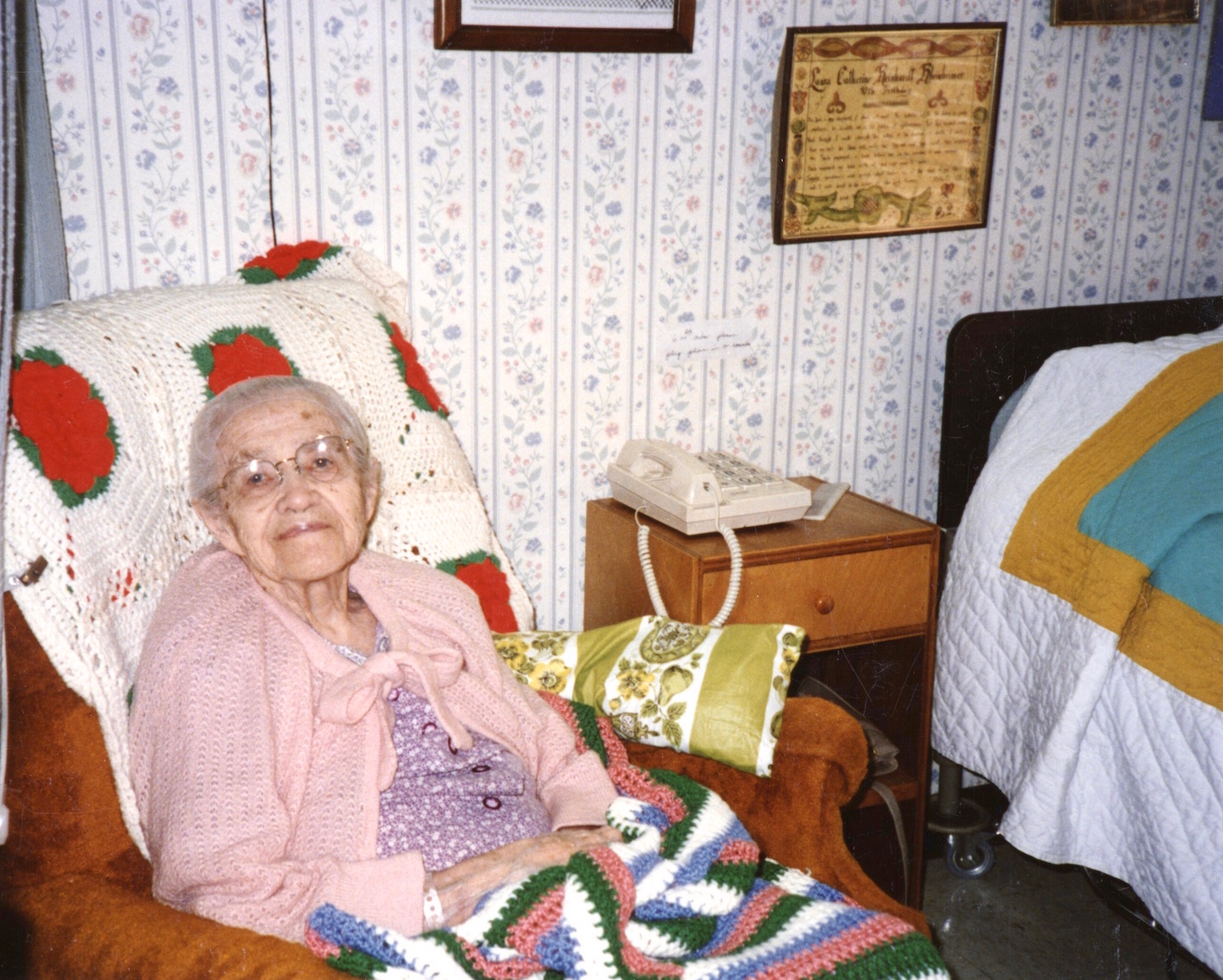 Rheinheimer, Laura Kathryn Reinhardt, 95, Goshen, Ind. Born: March 19, 1899, Minier, Ill., to John J. and Lizzie Ann Miller Reinhardt. Died: Friday, Aug. 12, 1994, Goshen, Ind. Survivors - children: Rachel E. Miller, Dora Hostetler, Lila Mishler, Florence Harnish, Floyd, Howard, Rollin, Ralph; brother and sisters: Ora Reinhardt, Mabel Schweitzer, Delcie Martin, Florence Martin, Mary Hooley, Stella Sutter; 33 grandchildren, 71 great-grandchildren. Predeceased by: Edward Rheinheimer (husband). Funeral: Tues, Aug. 16, 1994 at Waterford Mennonite Church, by Willis Breckbill, Sylvia Shirk Charles, and Lloyd Miller.
Rheinheimer, Laura Kathryn Reinhardt, 95, Goshen, Ind. Born: March 19, 1899, Minier, Ill., to John J. and Lizzie Ann Miller Reinhardt. Died: Friday, Aug. 12, 1994, Goshen, Ind. Survivors - children: Rachel E. Miller, Dora Hostetler, Lila Mishler, Florence Harnish, Floyd, Howard, Rollin, Ralph; brother and sisters: Ora Reinhardt, Mabel Schweitzer, Delcie Martin, Florence Martin, Mary Hooley, Stella Sutter; 33 grandchildren, 71 great-grandchildren. Predeceased by: Edward Rheinheimer (husband). Funeral: Tues, Aug. 16, 1994 at Waterford Mennonite Church, by Willis Breckbill, Sylvia Shirk Charles, and Lloyd Miller.
Ed's father, Jake, now age 28, married his aunt Mary on 13 March 1898 when she was 36. In their household west of Shipshewana Lake they were now rearing Jake’s sons, six-year-old Edward and five-year-old Frederick, and Mary Ann’s daughter, Hettie, almost four years old. Three-year-old brother, Ira, stayed with his foster parents instead of coming to live with his biological father and aunt since he had been 'given away' at three weeks. Although the remaining three children were first cousins, they were treated as siblings.
Ed continued to live with his father and stepmother through adulthood. Around age 25, when he was working in Kouts, IN, he met his future wife, Laura Reinhardt, by a chance acquaintance through her cousin, Elsie Miller. Laura was the daughter of John Jr and Lizzie Ann Miller Reinhardt. She had five sisters and two brothers: Iva, Laura, Mable, Delcie, Mary, Stella, Florence, Olen, Orrie, and Orvan (1 baby died without being named).
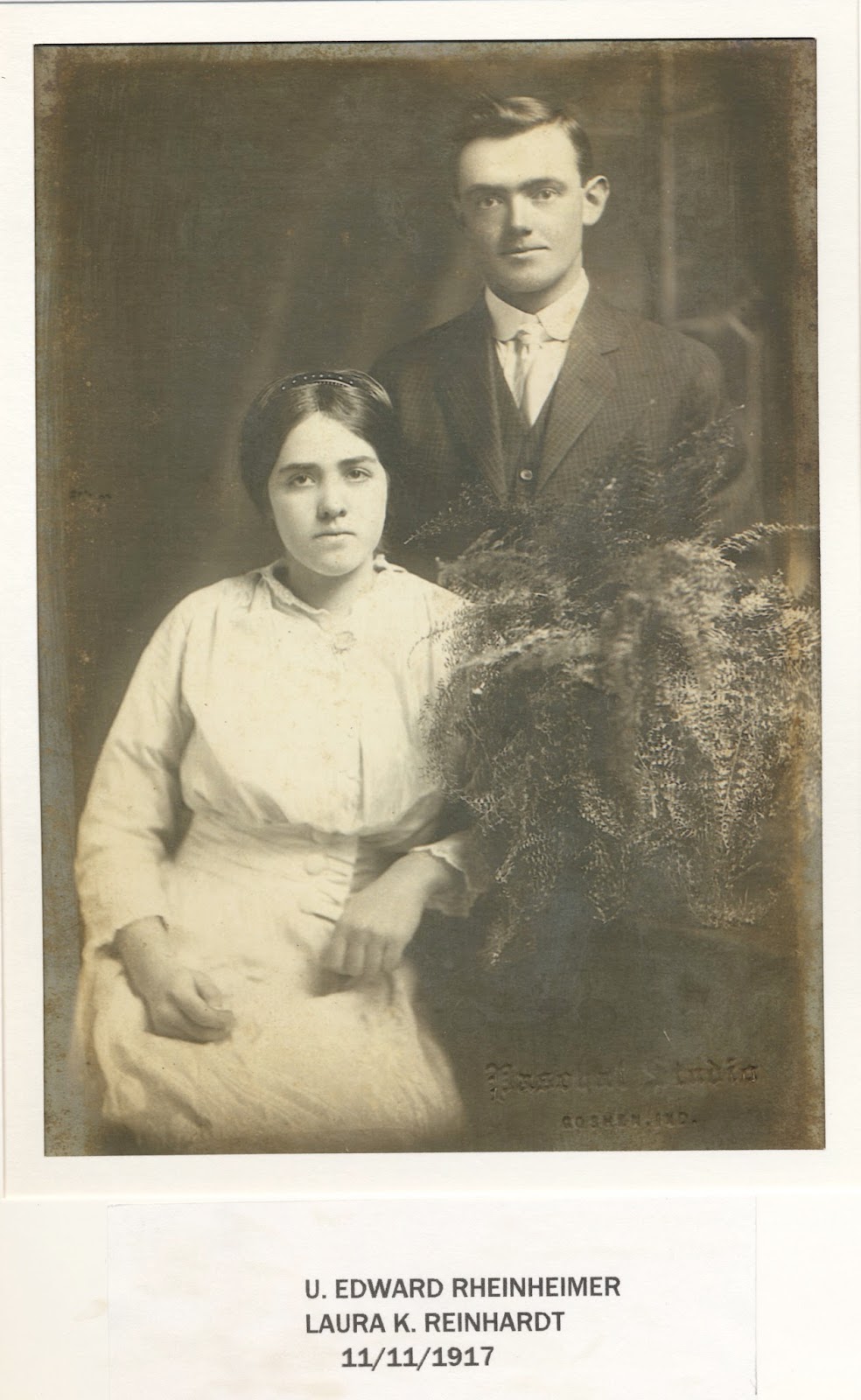 |
| Ed & Laura Rheinheimer wedding photo, Nov, 1917 |
With World War I raging in Europe, Ed and Laura married on Sunday, 11 Nov 1917, in Kouts, IN, when the circuit preacher came through. Unbeknownst to them, their wedding date was a year to the day before World War I would end.
Although the war had begun in 1914, the U.S. had remained neutral, even when Germany sank the British liner Lusitania on 7 May 1915 with 128 U.S. citizens onboard. President Woodrow Wilson declared that "America is too proud to fight" and demanded an end to attacks on passenger ships.
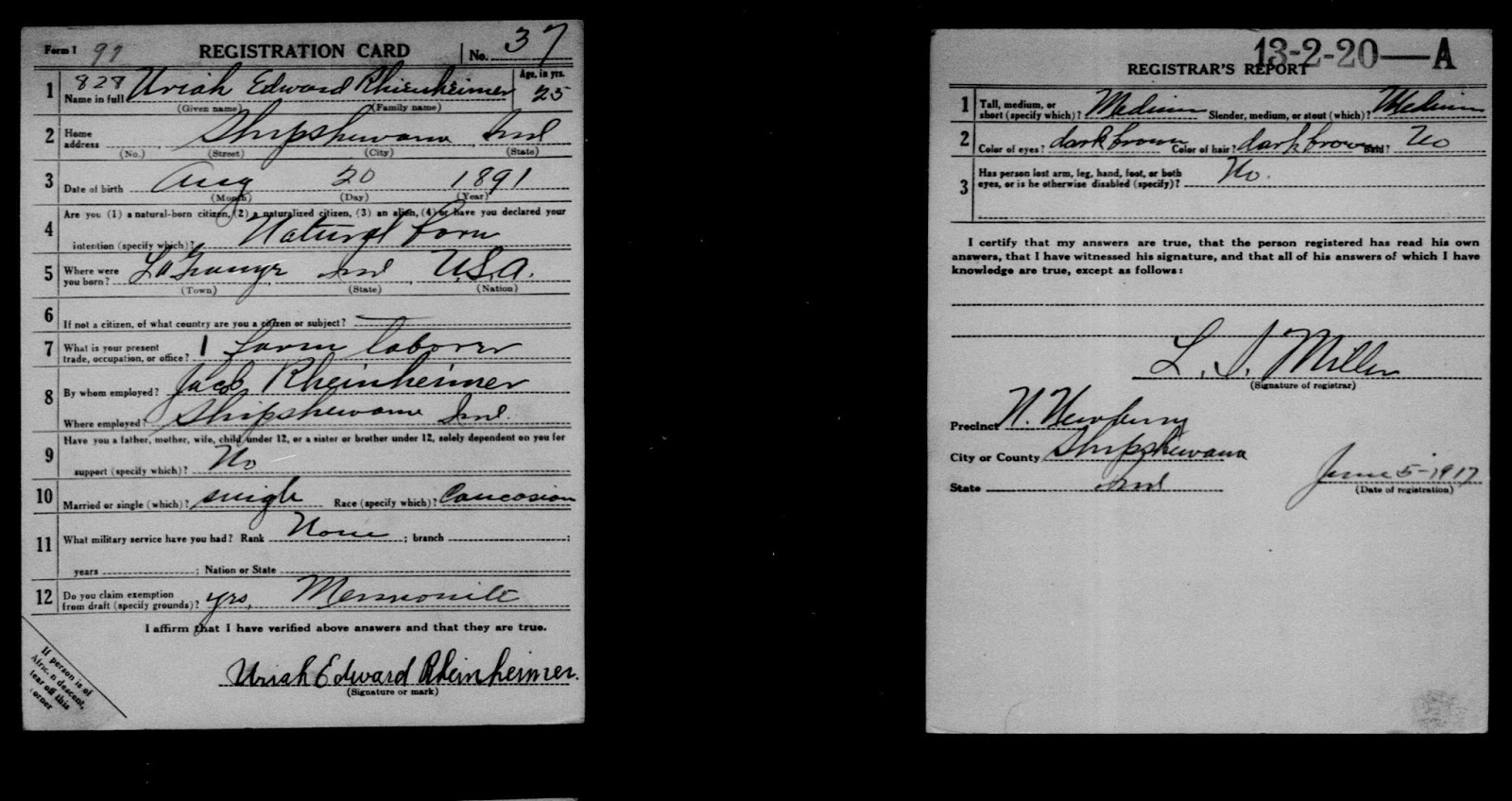 |
| Ed's military registration card in 1917 |
On Wednesday, June 6, Ed and his brothers, Fred and Ira, each registered. Ed listed his occupation as a farm laborer, employed by his father, Jacob Rheinheimer, in Shipshewana, IN. The last question, #12, asked, "Do you claim exemption from draft (specify grounds)? Ed responded, "yes, Mennonite," as did his brother Ira. Fred left his space blank. Only Ira was drafted into the war.
Despite the provision for conscientious objectors during registration, the Selective Service Act only provided objector status for those who were members of "any well-recognized religious sect." According to Mennonite Central Committee, that phrase proved to be ambiguous for draft boards who were arbitrary in classifying conscientious objectors.
Further, men who objected were not exempt from military service, they still had to serve in the armed forces as a noncombatant. So the military held direct authority over COs (conscientious objectors) and that created problems for many pacifists in the Mennonite church. The confusion and hostility that surrounded the absence of a specific definition of noncombatancy during the first world war led both the government and the objectors to rectify those problems a couple decades later when the second world war loomed for the U.S.
Although Ed would have been drafted in the next round of men, he narrowly escaped that fate with the war's end in November 1918. By then 24 million men had registered for the draft. Of the almost 4.8 million Americans who enlisted, 2.8 million had been drafted.
Is this what happened to Ed's youngest brother Ira? Despite answering Mennonite to the question of exemption on the draft registration form, Ira went into the army on 29 March 1918 and was exposed to poisonous mustard gas in France on 19 Oct 1918, less than a month before the war ended. It was the first time chemical weapons had been used in warfare.
Ira was given an honorable discharge on 9 May 1919. After he came home, he courted and married Anna Hostetler, and had three children, Don, John, and Shirley. Their daughter was born while living in Los Angeles, where they had moved to improve Ira's health. He spent time in the LA Veterans Hospital, making leather purses while there. The family moved back to northern Indiana before he died in 1933 at age 39, able only to speak in a whisper due to the mustard gas damage. His three children were aged 11, 9 and 5. His brother, Ed, was 42.
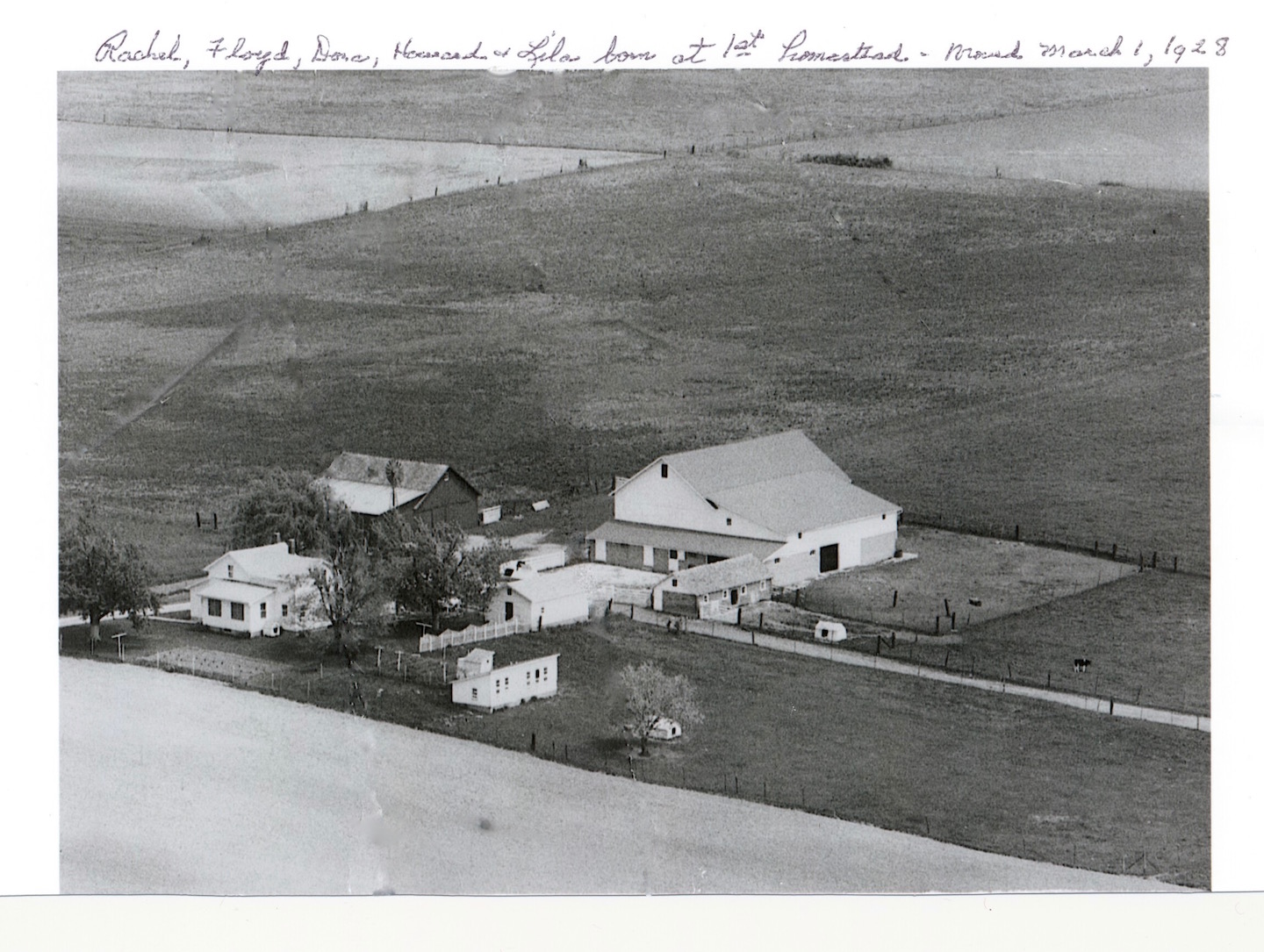 |
| First home in Pashan, IN, north of SR 20 on CR 1000 W Rachel, Floyd, Dora, Howard and Lila were born here |
Ed did not take the illness seriously and "just laughed and joked about it but I knew there was something serious wrong with him." She answered an ad in a paper from a Dr. Young and he suggested a diet for him that helped considerably. "From then on we had bread and milk for supper every evening. The doctor also said he should always eat cottage cheese with any kind of fruit. He didn't like cottage cheese but he knew it was a matter of life and death and he learned to eat it and eventually liked it.
"Dr. Esch in Shipshewana didn't seem to know what do do so he advised us to go to a specialist in Fort Wayne. We spent a lot of money with no good results. Ed was continually spitting up blood. And then (his father) Jake Rheinheimer stepped in and said he'd pay for chiropractic treatment which he did with no results. Finally Grandpa Jake decided it must be the water and he paid $16 dollars for a filter. I carried all the water into the house and put it in that filter but he still spit blood and couldn't work too much."
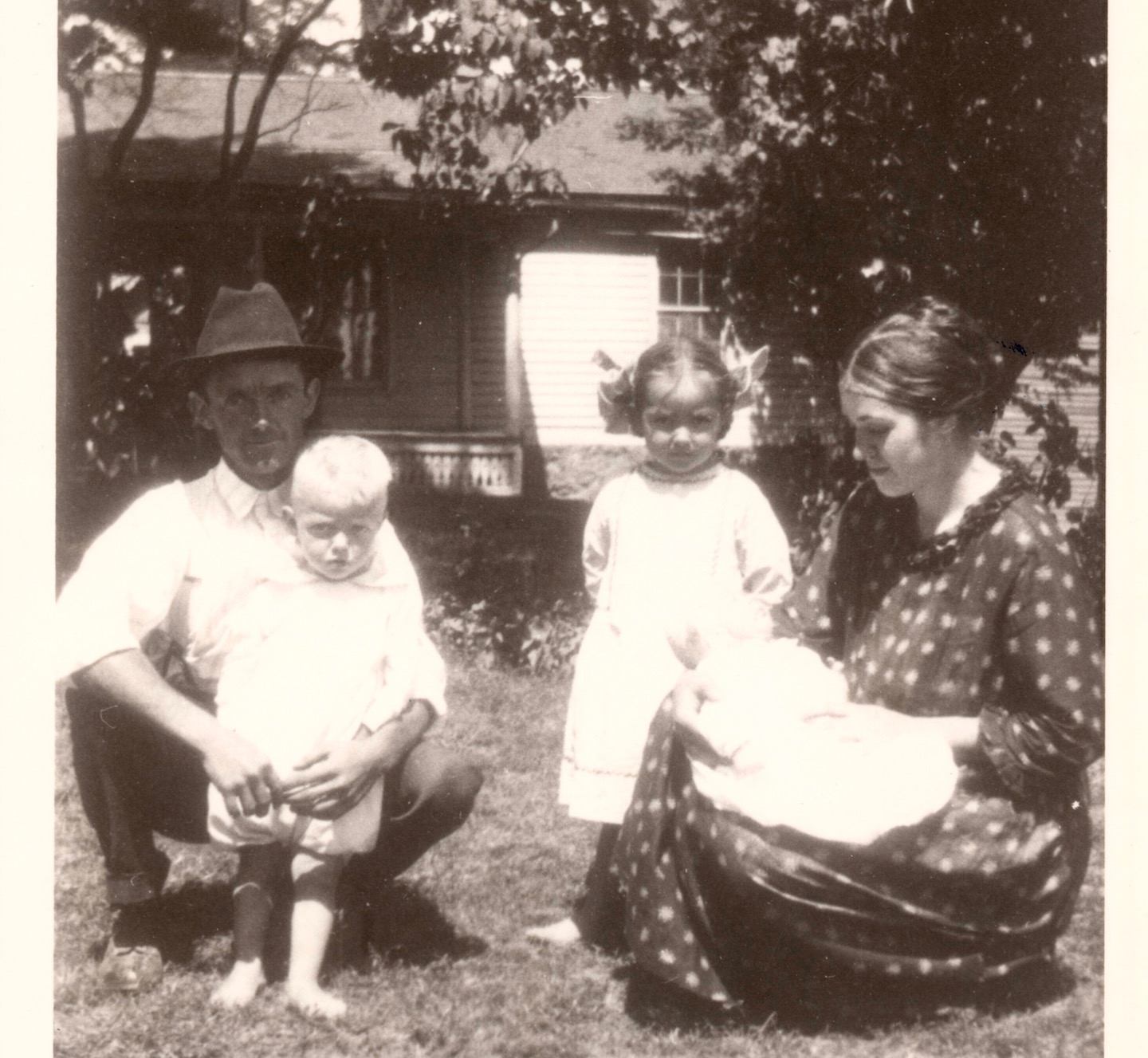 |
| Ed, Floyd, Rachel, Dora, Laura 1923 |
Rachel Elizabeth, b March 1920
Floyd Lavern, b October 1921
Dora Ethel, b June 1923
Howard Leroy, b May 1925
Lila Mae, b March 1927
Florence Marie, b Jan 1930
Rollin Richard, b March 1931
Ralph Edward, b Feb 1935
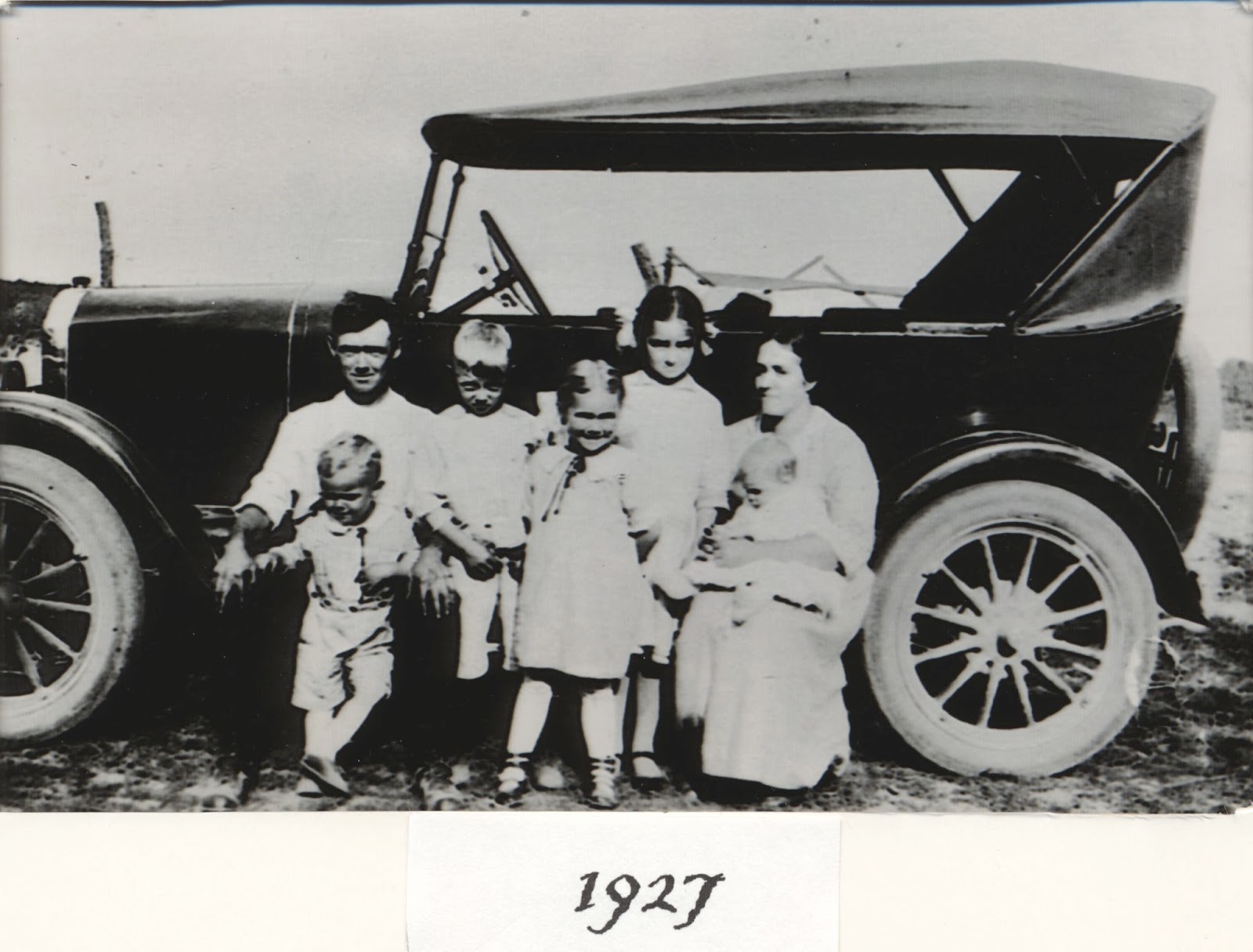 |
| Ed, Howard, Floyd, Dora, Rachel Howard, Laura in 1927 |
On 1 March 1928, Ed and Laura moved from their Pashan farm to a 120-acre farm on CR 850 W, just west of Shipshewana, IN. Five of their eight children were already born. Although the farmhouse had electricity, it did not have a furnace or an indoor bathroom. The privy (outdoor toilet) was located under the hog house, the same dusty building the children played in during their spare time. During the night, the children used an indoor pot that their mother emptied every day since she had no sense of smell.
A chimney that came through the two story home into the girls' bedroom kept them warm but not the boys' room, where it was very cold. The four girls slept in the same room with two double beds; likewise for the boys.
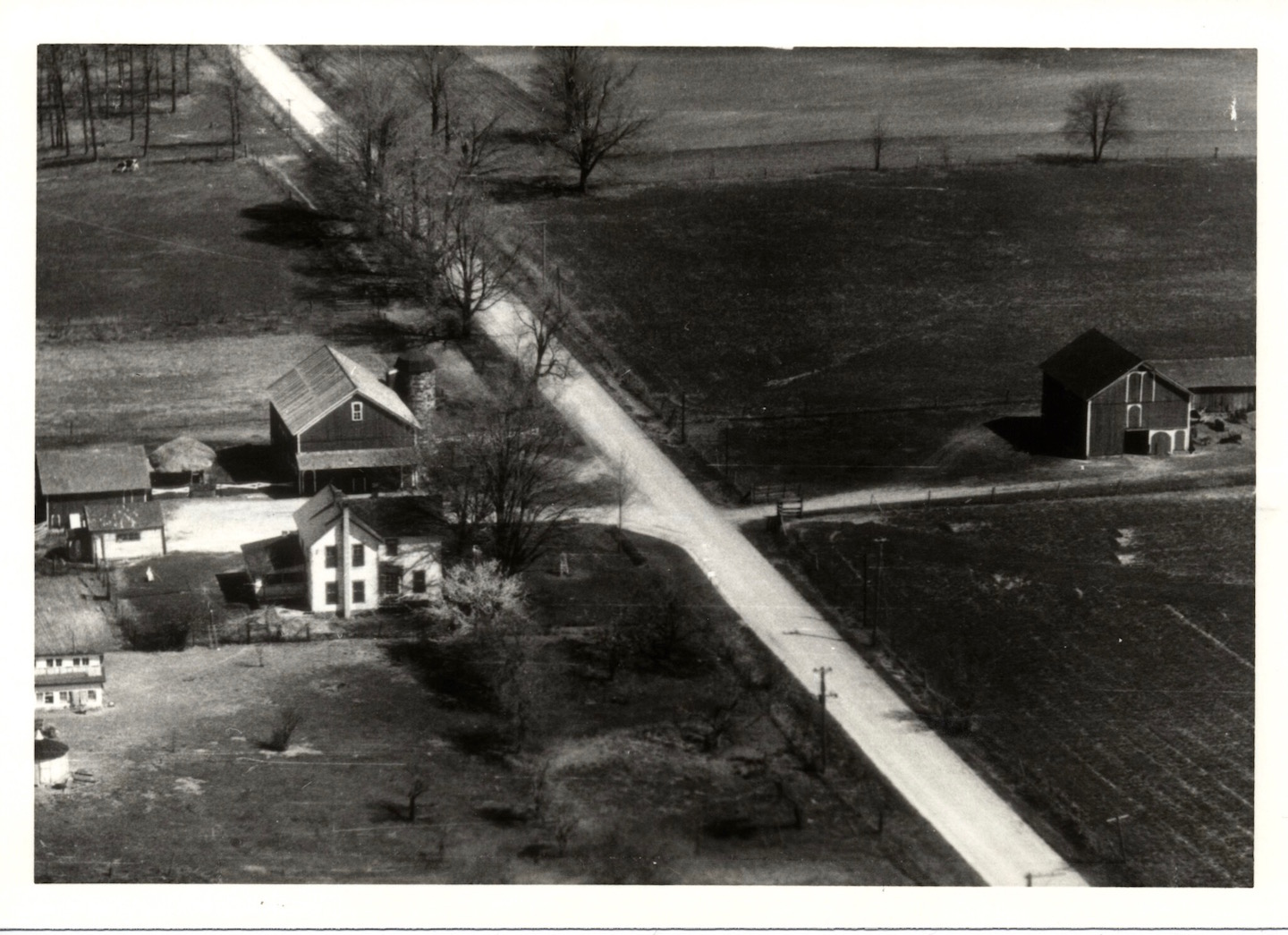 |
| Moved to new farm on March 1, 1928 Just west of Shipshewana, IN |
The growing family lived through the Depression years (1929-39) but did not lose their farm. They all worked very hard to ensure there was enough food on the table, one at which everyone gathered together for breakfast, dinner and supper every day. A quote on the wall in their dining room read,
Rules for Today
Go no place you would not like to be found when Jesus comes.
Say nothing you would not like to be saying when Jesus comes.
Do nothing you would not like to be doing when Jesus comes.
 |
| Laura feeding the 700 chickens ~1929 |
They grew an acre garden, which supplied them with fresh produce during the summer months. Every other row had flowers so that when the produce was finished they still had flowers to enjoy. Laura also baked three loaves of bread three times each week and bought additional loaves from the bread man to feed her active and growing family. She canned hundreds of jars of vegetables and fruits each year to supply them through the winter months. When canning, she used a glassed in porch with open doors on each end but it was still very hot and sweat would drip into the metal canner as she boiled the jars of food.
For ten years the family also grew and harvested an entire acre of tomatoes, which they sold to a cannery in Shipshewana that made ketchup. Lila recalled that despite being tired after school, the children heard their mother call to them each day as they were walking down the road toward the farmhouse. "Change your clothes and come help me pick these tomatoes!" The boys helped to plow the fields with horse-drawn implements and the girls cooked and cleaned the house. There was always much work to be done.
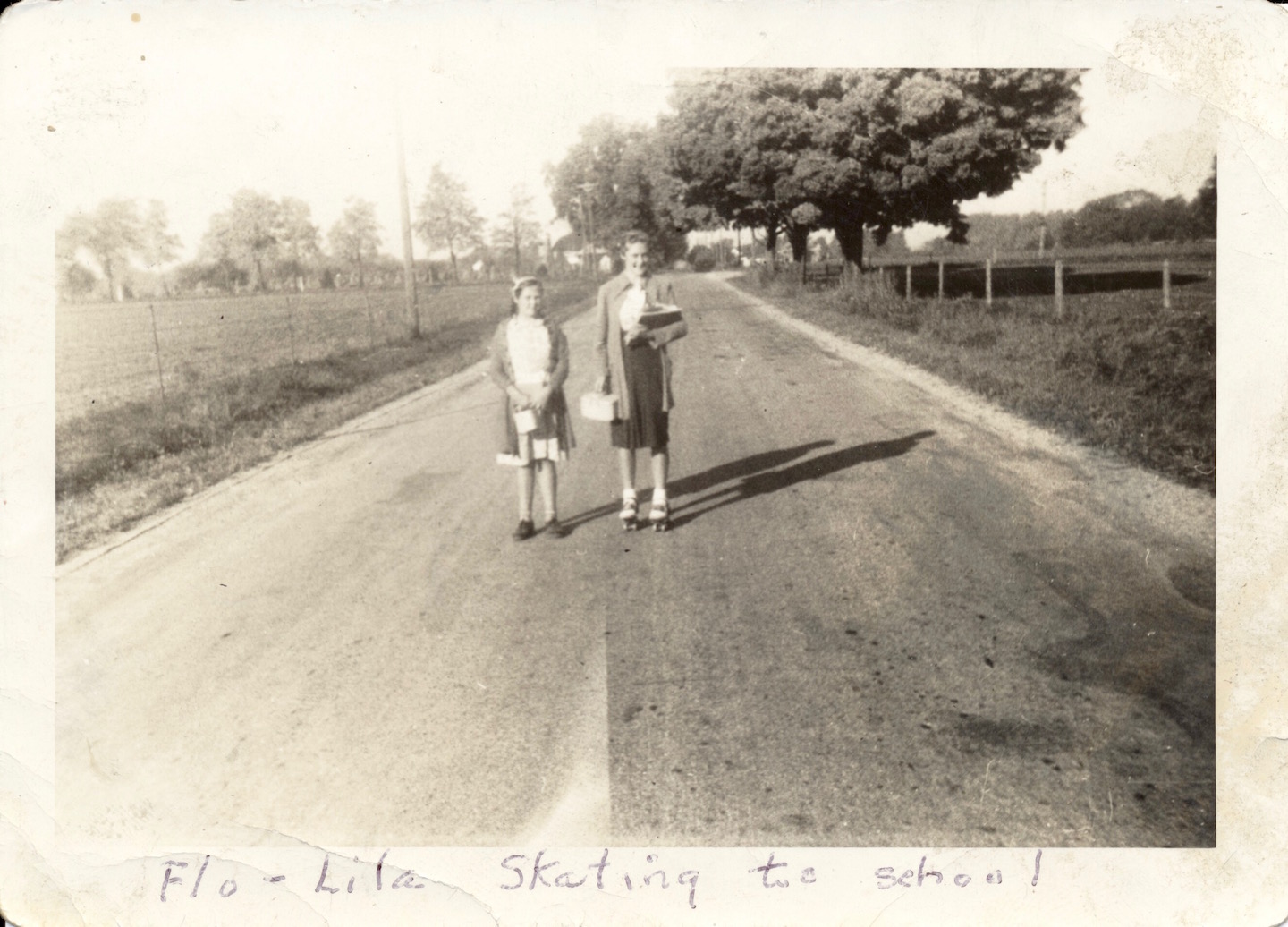 |
| Florence & Lila rollerskating to school |
Gradually Ed improved and Laura concluded that he must have had TB and a later x-ray confirmed it. She was grateful no one else contracted it from him.
Although there was barely enough food for the growing family and seldom enough money, Lila and Howard recalled the day that many more persons unexpectedly arrived at their house. On Christmas morning, 1939, a car filled with children and a chest of drawers tied to the roof drove onto their farm. Ed silently stared at it out the window for a long time and eventually said, "That's my brother Fred."
Apparently Fred had left North Dakota under cover of darkness to escape debts. He and his wife, Gertrude (Gertie), and eleven of their 13 children climbed out of the car seeking temporary shelter at Ed and Laura's house. (Their two oldest children, Tim and Raymond, were already living in the area.) The family stayed about two weeks, sleeping on floors wherever there was space, until they found other living arrangements with friends and distant relatives. The 1940 census shows 48-year-old Fred living on Middlebury St. in Shipshewana with Gertrude, age 40 and six children.
Like his father, Ed was a quiet man, but also curious. He continued his father's occupation of horse breeding as a source of income. He was known in the community as a country vet since he was knowledgeable about horses, educating himself through a course, books and experience. He trained and "broke" horses that others could not. Family lore said he once beat a horse to death - was it during a training session?
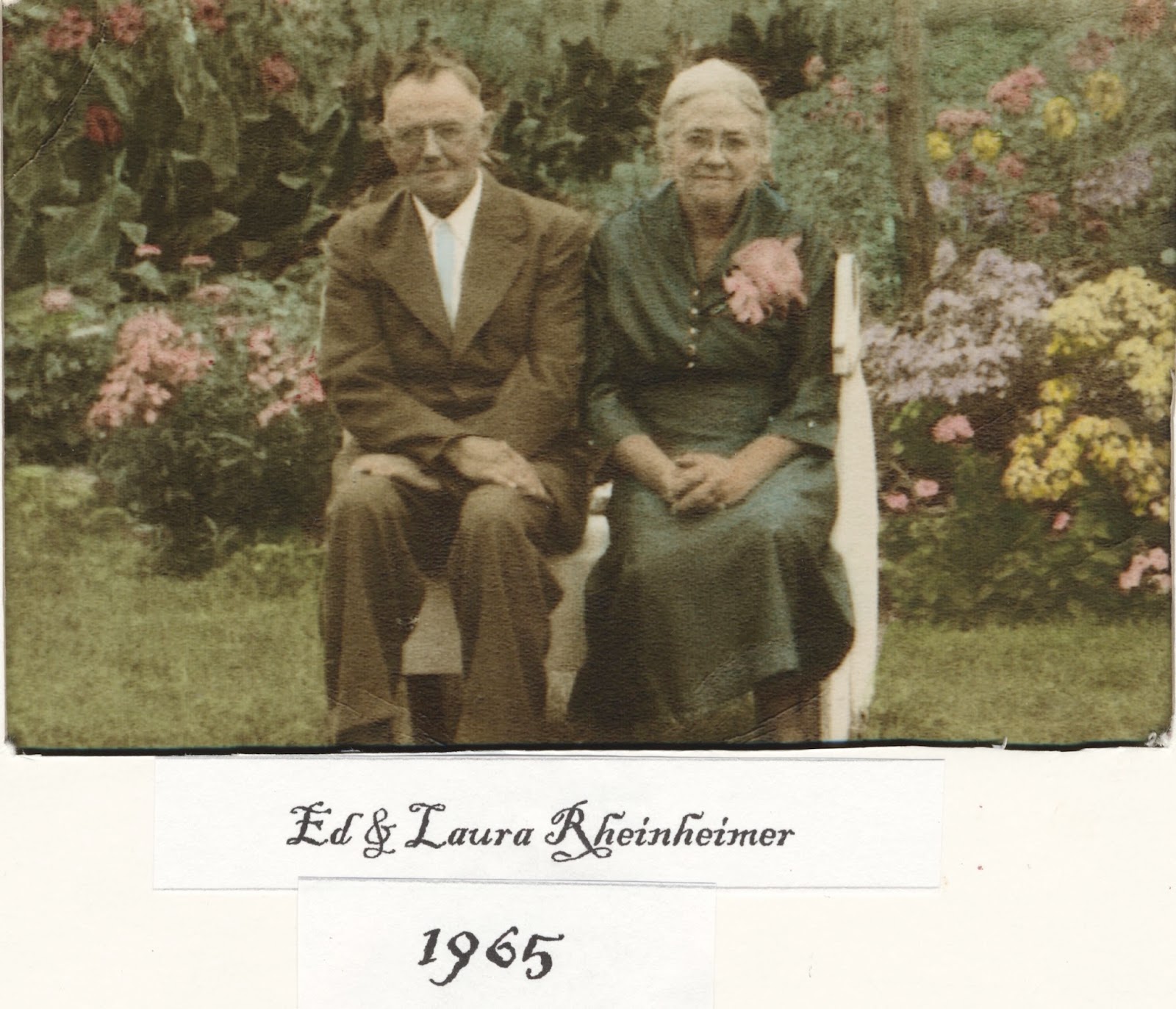 |
| Ed never wore ties - only a shirt with a blue tie painted on. |
Farm life was difficult and money was always in scarce supply. Lila remembers her father asking to borrow $1 from her when she was working in high school and it taking him two weeks to pay her back. She often bought groceries for the family with the money she earned working at the drugstore. After all but the youngest child, Ralph, had left home, Laura and Ed received $2000 inheritance from Laura's parents in 1951. They used it to install a furnace and an indoor bathroom. In 2016, the equivalent amount would be nearly $20,000.
In 1957, when Ed was 66, they sold the farm on CR 850 W and bought a house on US 20, south of Shipshewana, a road that Ed had helped to build. One week after Ed's 70th birthday, his brother, Fred, died at age 68 on 27 Aug 1961. He was buried in Shore Cemetery. Fred's wife, Gertrude, would die in 1988.
On 11 April 1965, their house on US 20 was blown away in the Palm Sunday tornadoes. The couple saw the storm approaching and took shelter underneath a sewing machine cabinet in their basement. Fortunately neither sustained life-threatening injuries. After the storm, they lived with their nearby daughter, Lila, for two weeks and then in a mobile home on on the same property before moving to a house on Harrison St. in Shipshewana.
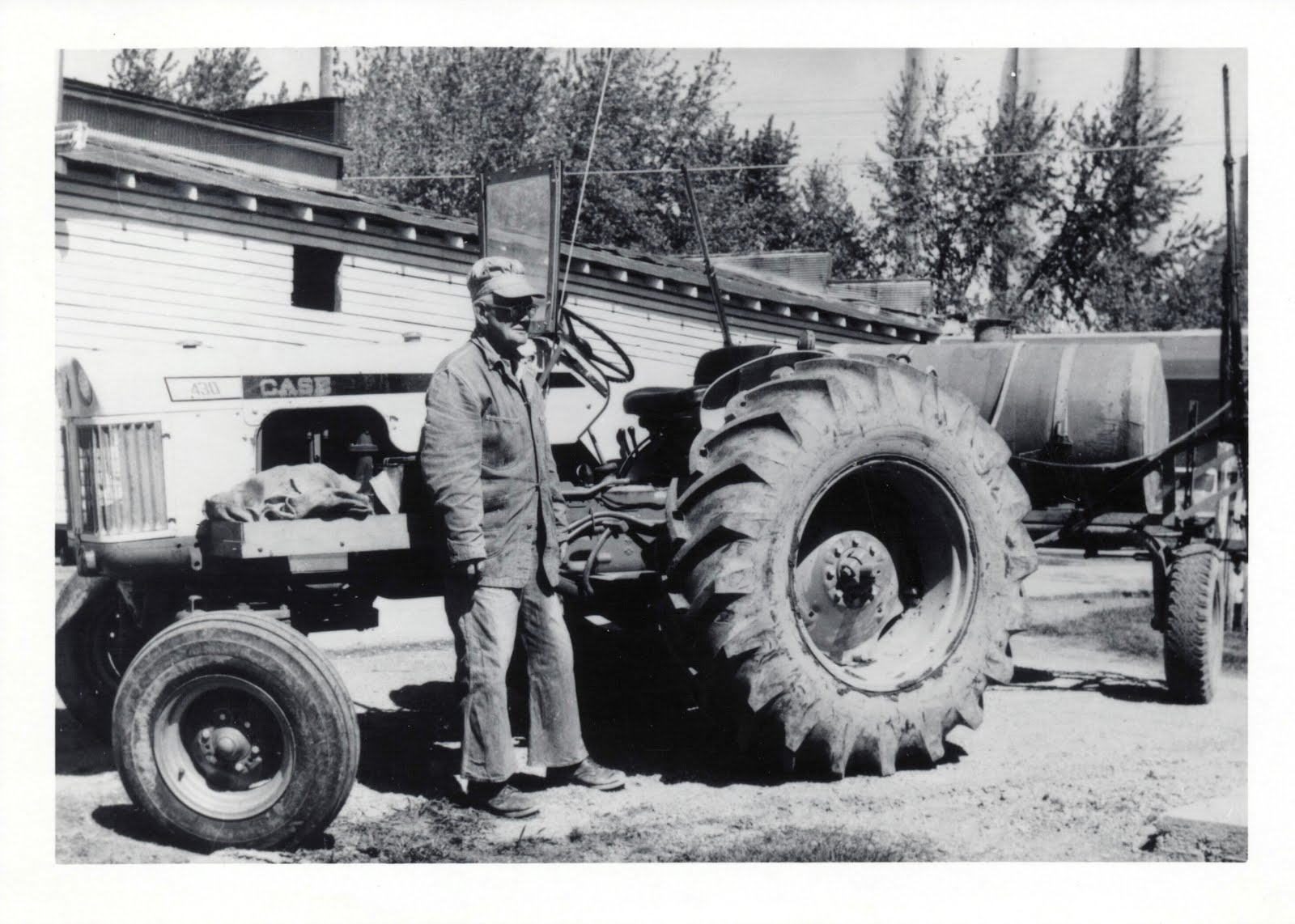 |
| Ed with his Case tractor and spraying equipment.This is the last known picture of him. |
With eight children in 15 years there were many incidents and accidents. Despite broken bones and wounds that needed to to be sutured, each of Ed and Laura's children lived to adulthood. In fact, not only were Ed and Laura married for 55 years, each of their eight children was married for over 50 years to their respective spouse.
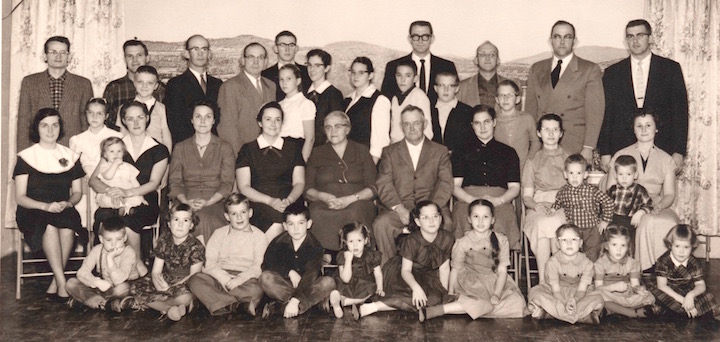 |
| A full gathering of Ed and Laura's family around 1960 |
In 1972, 81-year-old Ed was working as a plumber. On Sept 27, he was driving his truck to a hardware store in Shipshewana to pick up a part for a customer who reported the toilet Ed had serviced the day before was not working properly. With the repair on his mind, he turned left in front of an oncoming pickup truck and was hit head on. Ed was thrown through the windshield about 50 feet and bleeding profusely. A man who was working at the hardware ran out to assist. Although Ed wanted to get up, he wanted to get up but the man insisted that he stay lying down. He was first taken by ambulance to LaGrange Hospital and then transferred to Parkview Hospital in Fort Wayne where he died during surgery.
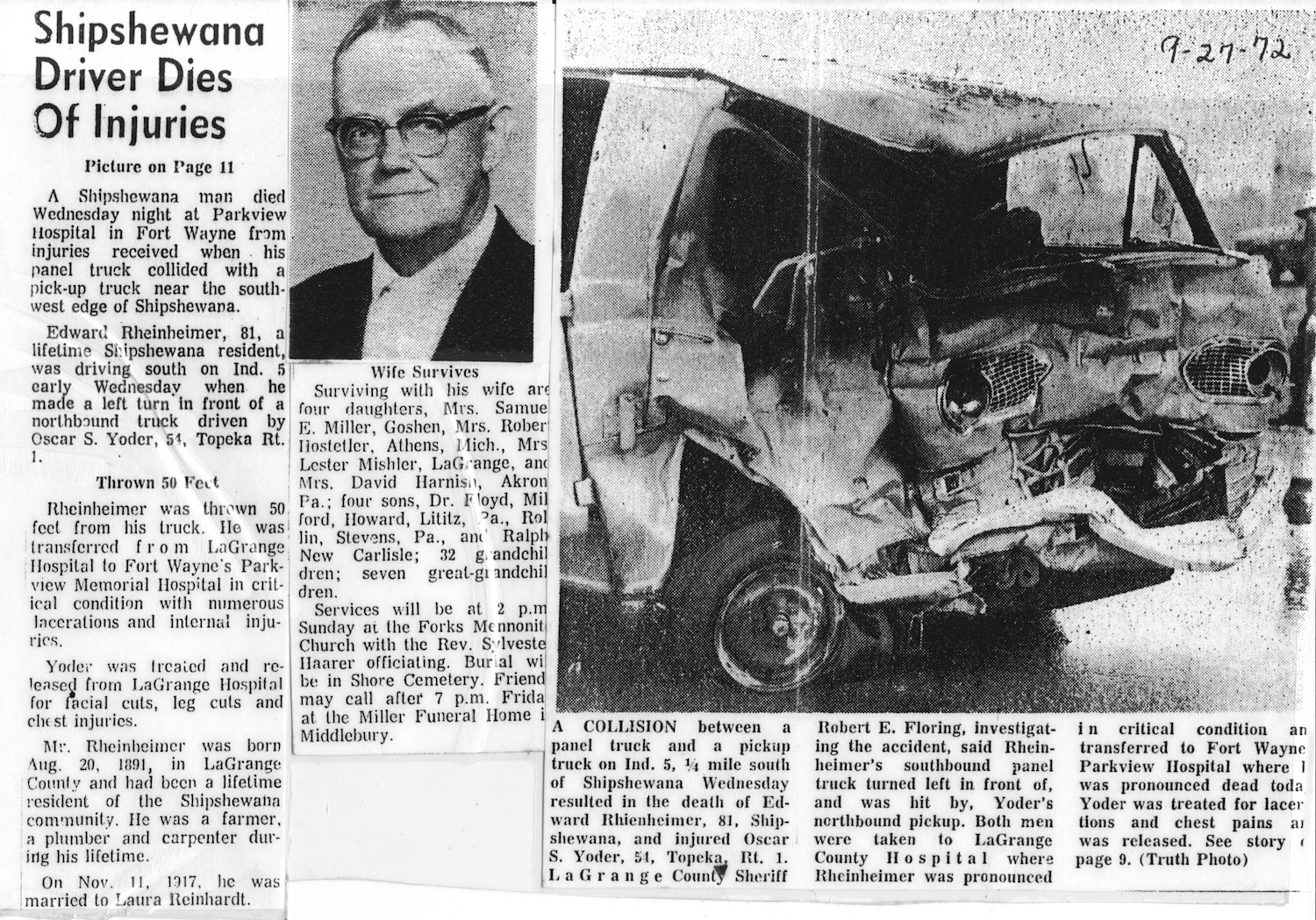 |
| From the LaGrange Standard |
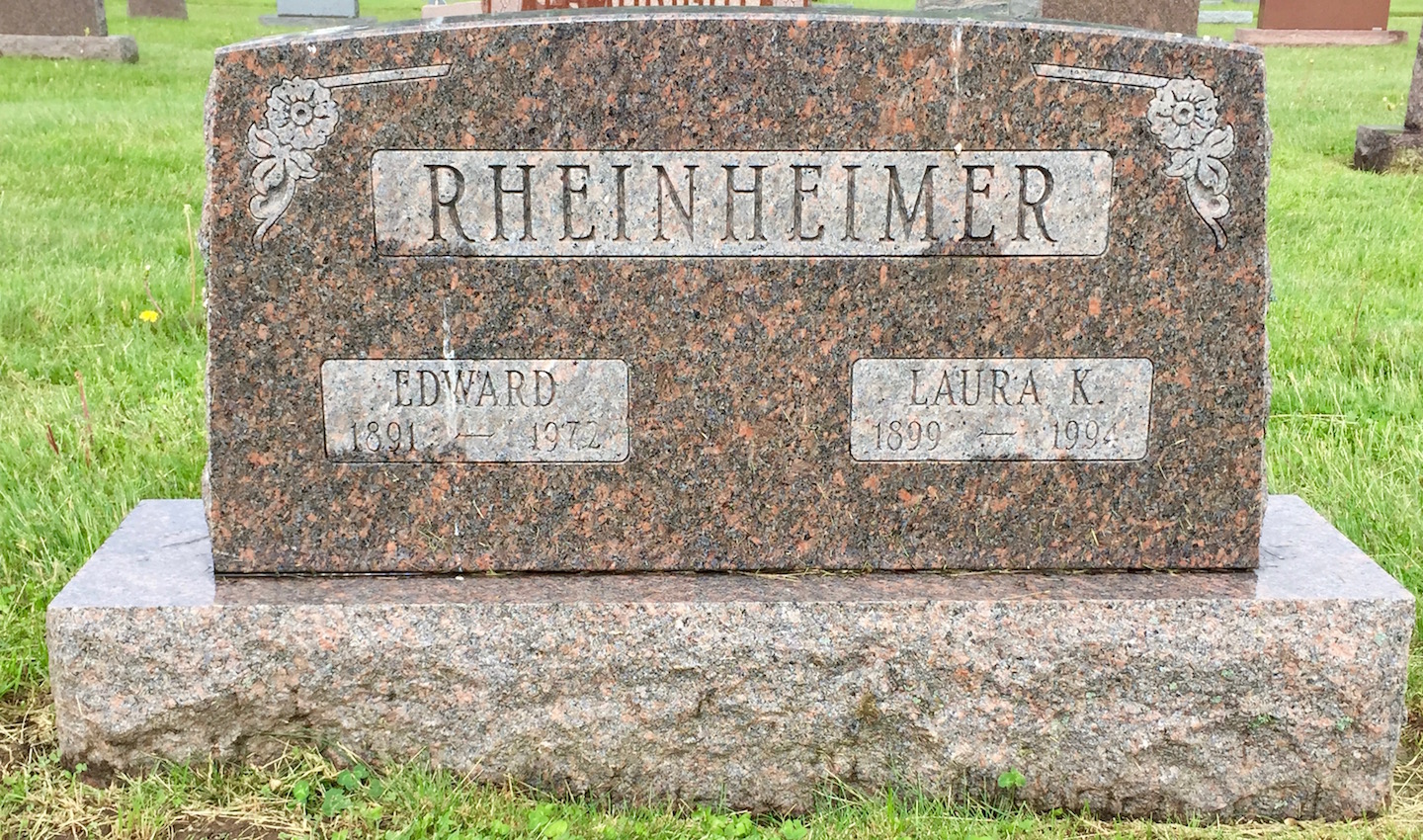 |
| Tombstone in Shore Mennonite Church Cemetery Shipshewana, Indiana |
What kind of man was Ed? Here are some phrases from people who knew him:
"Kind, wanted to help others, always smiling, a good neighbor." Amish co-worker (plumbing), Levi Jones, born 1914
"A bit like his dad but not brutal, boss of the house, wanted to help others." Howard Rheinheimer, son
Laura eventually sold Ed's tools and their house in Shipshewana, moving to a new house in Waterford, just south of Goshen. There she was closer to her oldest daughter, Rachel, who took on primary care for her mother. Laura moved to Greencroft Retirement Communities in Goshen when she could no longer live alone. She died at age 95 in 1994, 22 years after Ed's death.
 Rheinheimer, Laura Kathryn Reinhardt, 95, Goshen, Ind. Born: March 19, 1899, Minier, Ill., to John J. and Lizzie Ann Miller Reinhardt. Died: Friday, Aug. 12, 1994, Goshen, Ind. Survivors - children: Rachel E. Miller, Dora Hostetler, Lila Mishler, Florence Harnish, Floyd, Howard, Rollin, Ralph; brother and sisters: Ora Reinhardt, Mabel Schweitzer, Delcie Martin, Florence Martin, Mary Hooley, Stella Sutter; 33 grandchildren, 71 great-grandchildren. Predeceased by: Edward Rheinheimer (husband). Funeral: Tues, Aug. 16, 1994 at Waterford Mennonite Church, by Willis Breckbill, Sylvia Shirk Charles, and Lloyd Miller.
Rheinheimer, Laura Kathryn Reinhardt, 95, Goshen, Ind. Born: March 19, 1899, Minier, Ill., to John J. and Lizzie Ann Miller Reinhardt. Died: Friday, Aug. 12, 1994, Goshen, Ind. Survivors - children: Rachel E. Miller, Dora Hostetler, Lila Mishler, Florence Harnish, Floyd, Howard, Rollin, Ralph; brother and sisters: Ora Reinhardt, Mabel Schweitzer, Delcie Martin, Florence Martin, Mary Hooley, Stella Sutter; 33 grandchildren, 71 great-grandchildren. Predeceased by: Edward Rheinheimer (husband). Funeral: Tues, Aug. 16, 1994 at Waterford Mennonite Church, by Willis Breckbill, Sylvia Shirk Charles, and Lloyd Miller. This site powered by The Next Generation of Genealogy Sitebuilding v. 14.0.2, written by Darrin Lythgoe © 2001-2024.
Maintained by Randal Rheinheimer.


